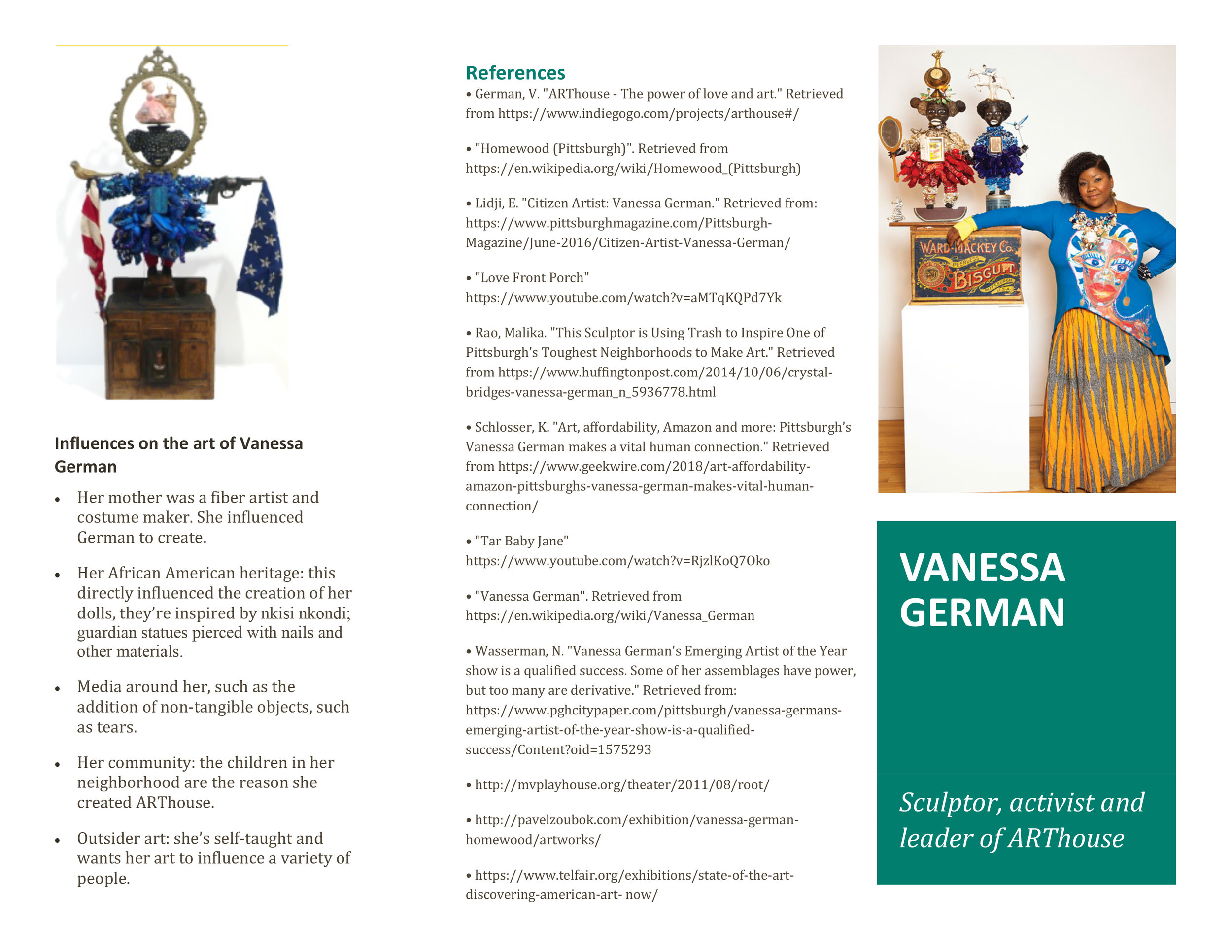Personal History:
Meet Vanessa German. It is her given name. She is gay, unmarried, and has no children but she has seemed to have taken on the children of the community as her “children.” She lives with clinical depression, and feelings of worthlessness. All of these things inform her art, but they do not necessarily define it.
She is an African American contemporary artist, working primarily in found object sculpture and performance art. She was born in 1976 in Wisconsin, but lived most of her childhood in Los Angeles and briefly, Loveland, Ohio until the year 2000 when she moved to Pittsburgh, Pennsylvania with her parents and settled there. Her work is heavily influenced by her childhood in Los Angeles, where she grew up in a lower socioeconomic neighborhood and where her mother taught her to be self reliant, and do things such as make her own clothes. In 2010, the documentary “Tar Baby Jane” showed her living in a house that was going into foreclosure, at the same time her artwork was getting more and more recognition. She is also influenced by her community, from the AIDS epidemic to drive-by shootings. Although she has become a well established artist in recent years, German lives in the Homewood neighborhood of Pittsburgh, a predominantly African American area of the city. The neighborhood was the center of a lot of racial issues throughout the 20th century, as well as gangs and violence in the 70’s and 80’s. Since then, it has been rebuilt through building homes and opening businesses. In spite of this, it has still been described as “The Most Dangerous Neighborhood in America.”
Art and Influences:
German combines these experiences she has with her community with some aspects of her African heritage to create her work. Her mom was a fiber artist, quilter and costume maker, and also influenced German to become an artist. She is largely self-taught, and creates female figures that she calls “power figures” or “tar babies.” Using found objects, she says this relates to the central African tradition of nkisi nkondi, guardian statues pierced with nails and other materials. The fact that they are “dolls” which is partly her “experiencing delight” that she missed as a child since she grew up poor and did not get dolls as a young girl, and also turning something innocent into something controversial with her subject matter.
She creates them by decorating and painting large dolls and figures, using found material such as cowrie shells, plastic guns, feathers, bottle caps, seashells, toys and vintage products. Some of these items are found or donated from her Homewood neighborhood.
She lists her materials as both physical and “non-tangible”, for example, “the names of all the dead boys that I know” or “tears.” Some themes found in her work include food, birds, violence, injustice, poverty and Black Madonna imagery. She also uses color symbolically: “If they’re red, they’re holding rage and love simultaneously. If they’re white – they’re holding ghosts – the presence of your ancestors… and they’re also holding forgiveness and peace.”
She primarily creates her art in her home in Homewood. German originally had a studio which happened on her front porch because her basement was not large enough. This attracted the attention of many local children and eventually expanded into a community art space called the ARThouse. She worked to support her career as an artist until gaining recognition for her community art efforts.
She was named the “Emerging Artist of the Year” in 2012 by the Pittsburgh Center for the Arts, and is largely a part of outsider and African American art groups and gallery showings. She is largely involved in community and reaching out to those who don’t consider themselves artists or need art to realize their worth.
Her Big Idea/Legacy:
She creates work to connect to and tell the story of her community, which is also exhibited largely throughout the country. Some of her showings and the pricing of her art are at odds with her intended meaning and community work. At the root of her work is love.
Critic Perspective/Conclusion:
German has received largely positive reviews of her work by critics. One reviewer, Kurt Schlosser wrote: “As a visitor to Pittsburgh, and a newcomer to German’s work, I was the one who was struck silent, and left in awe in the presence of a woman who commanded her space with a captivating mix of glitter and beadwork and found objects and doll parts and so much more. Her presence was at the forefront as she wove a narrative of history and slavery and struggle and racism and oppression.” (geekwire.com)
The Crystal Bridges Museum of Art describes German as a “force of nature.” Her work has been described as “compelling”, “imbued with beauty and magic” and a “vital and amazing artist” (Telfair.org).
Nadine Wasserman of the Pittsburgh City Paper called German’s work “Positive and powerful” but “mostly derivative.” However, her ability to “accumulate, repurpose and create, so that objects not only carry the weight of history but also the power of renewal.”
We feel that although the subject matter has been addressed by other artists, Germans take on it has a strong contemporary influence, especially regarding her local community with ARThouse, as well as reaching across the line to the more affluent population of the country, such as her showing at the Carl Hammer Gallery. A lot of worked that we viewed by Vanessa German at the gallery was white in color, which suggests that she may have chosen these particular pieces to tell a narrative to the people who would be viewing it (ghosts, forgiveness). Her work is about connecting to the community and bringing worlds together through messages of criticality about history and the current world we live in. We believe that the work German is creating is relevant and is an important part of our past, present and future as art educators.
Artist Brochure





